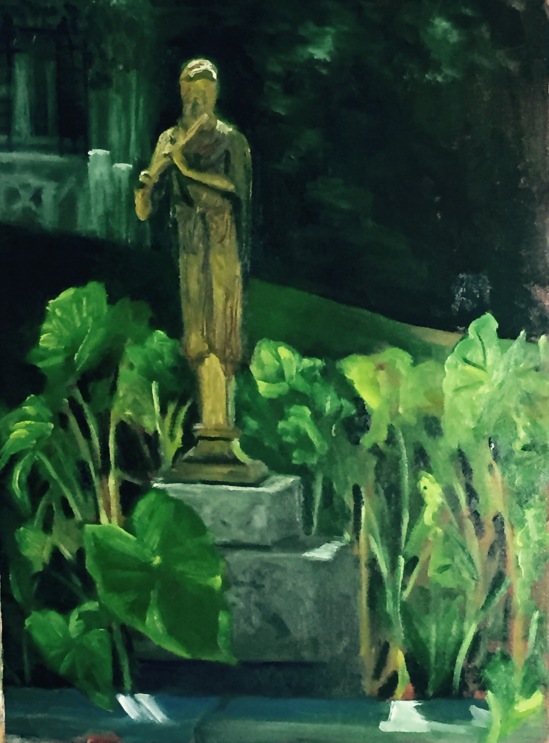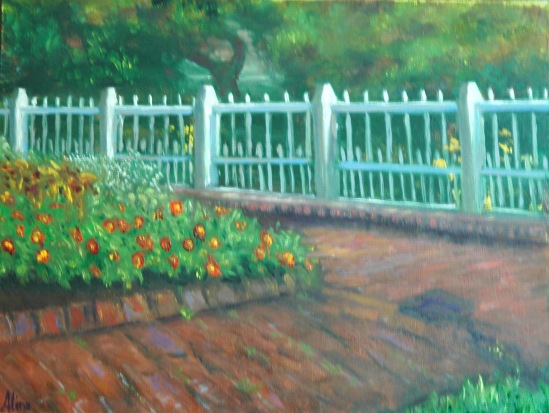We hit two locations last week: Wednesday at St. Gaudens National Park in Cornish, NH; and Sunday near Mt. Washington and Crawford Notch. Both times I was with Sharon Allen and Betty Brown, and on Sunday, Mary Crump and Jim O’Donnell joined us. Sunday was Day Three of the annual International Plein Air Painters (IPAP) paintout. I had to skip Days One and Two because of schedule conflicts. I think that was a good thing–I was fresh and rarin’ to go on Sunday.
Augustus St. Gaudens was a sculptor. His two most famous sculptures are the Shaw Memorial, which sits outside the State House in Boston; and Diana, the largest of which lives at the top of Madison Square Garden. A small Diane graces the Currier Museum in Manchester, NH, and another large one is on display in St. Gaudens’ studio. This is the view of her that I could get from the doorway; I was not allowed inside because of my canine companion, Justice.

St. Gaudens’ Diana
Justice was with me as a treat for him. When I leave him at home, I have to lock him in the bathroom because nothing else seems to contain him when he gets the urge to defecate in the living room. To the list of outdoor painting problems, therefore, I have to add the possibility that your dog will scare off strangers who might want to see (maybe buy?) what I am painting. He was pretty good on Wednesday; only chose to bark at two people. Nobody was interested in what I was doing anyway–they were there to see St. Gaudens.
The statuary found in the gardens outside his home were not his pieces. However, he chose the statues to decorate his garden, so they must have enough artistic merit to justify a painting of them. For my first painting at St. Gaudens, I followed Betty’s lead and painted a statue of Pan standing over a fountain of sorts and surrounded by plants with huge arrow-shaped leaves, similar to a house plant that I used to cultivate but whose name has slid out of reach in my memory. Here is my photo of the statue, followed by my painting.

Pan’s Garden

Statue of Pan
Mind you, the light had changed between the time I took the photo and when I got to the point of lighting my composition.
For my second painting (usually I paint two in a day when we are out for the whole day), I wanted to include St. Gaudens’ house. I also fell in love with the light hitting an ornamental grass that graced flower pots that line up to lead down from the house into a semi-secluded outdoor room. Here is my first taste:

Line of sun-struck grasses
Just as I got set up to paint, a rain cloud arrived and slowly passed over. I checked my iPhone, and as far as it was concerned, the sun was still shining. So I sat tight, using two sun umbrellas to shelter in place. Justice was not pleased. I suggested to him that he could get under the chair I was sitting on for pretty good protection, but no, he had to rely on my easel/palette tray.
Here is what my subject looked like for about 20 minutes.

St. Gaudens home in the rain
As a result of the rain shower, and perhaps also the complexity of my subject, I could not finish the painting of the house and garden. I may use photo references of the grasses later to complete the floral grouping in the foreground.

St. Gaudens house and garden (WIP)
Justice did not accompany me on Sunday to Crawford Notch. On Saturday, a friend took him away to Massachusetts for sleepovers, but that left the Great Dane, Honey, all alone. I lined up a few people to let her out periodically.
On our way up to Franconia Notch, the weather was concerning–cloudy, drizzly. Then it perked right up as we continued north of the Notch, on past the Mt. Washington Hotel, which coincidentally was hosting a major art fundraiser for the northern forest. We had to get to the Willey House because Betty and perhaps others would be meeting us there for IPAP. The weather deteriorated. Clouds were very low, and it felt as if it might drizzle at any moment. But it didn’t! We stuck it out. My painting seems to have darkened as it dried, which is odd. If I had had sun lighting my canvas, I would have painted too dark, but I certainly had no sun that time.

Webster Mountain under cover
The ducks were bobbing around back and forth all day, and whenever a new person approached the duck food (actually fish food but apparently good for ducks too) feeding station (25 cents a pop), they would swarm toward that person. I had to have a few ducks in the painting. Those white blobs represent the white feathers. The rest of them–grays, browns– kind of get lost in the water. Here is a different photo of the painting, a little too red but without that bleached out spot and better for discerning ducks:

Webster Mountain under cover
After having lunch at the Willey House, we headed up to the Mt. Washington Hotel. The sun was still shining on the Hotel, but the mountains were still obscured with clouds. In addition to sun, this spot had wind. Most of the artists who were there painting not for IPAP but for the fundraiser were set up on the leeward side of the wide veranda that encircles the hotel. Betty and Mary joined them, while Sharon, Jim and I went in search of an angle from which to paint the horse that we had spotted as we drove into the hotel. It wasn’t easy because of the distance the horses were from the road, and the impossibility of getting any closer. That last line of defense for the horses were cattails, ergo wetlands. The closer vegetation was probably infested with ticks. Wimps we were. And when I sat to paint (which is how I have to now), my line of sight on the horses did not include any legs. Perhaps just as well. I have not painted many horses, and all I had to worry about was the body, neck and head. Legs and feet can come later.

Horses under gray sky
I painted the horses on a panel toned with cadmium red. You can see hints of that red here and there. The sky was the last piece I put in. I liked it with the bright red sky. I hated the whitish gray sky. So before it dried completely, I tried wiping out the whitish gray.

Horses with Pink Sky
Red appealed to me I think because it is dark, and I wanted a dark value in the sky so as to increase the attention paid to the field. It is hard to determine the value of red as juxtaposed to other colors. I supposed I could make a dark blue sky.
So that is what came from two days of painting outdoors in the fresh air, sunny and cloudy and sometimes wet. Before I close, I know that Bad Cat acquired some fans, so here is another shot of him in my bed. His real name, by the way, is Blue. Bad Cat Blue.

Aline Lotter is currently exhibiting:
At the Bartlett Inn in Bartlett; at the Bernerhof Inn in Glen; at the Red Jacket Inn in North Conway; and at the law offices of Mesmer and Deleault at 41 Brook St in Manchester.
As usual, you may view paintings with prices and order prints, iPhone cases and the like at my Fine Art America page. If the painting you are interested in is not there, or if you prefer to bypass that experience, you may contact me by email to alotter@mac.com.
If you want to add a public comment to this blog, go to the bottom of this page where it says “Leave a Reply”, and enter your comment in that box. I love to get public comments, so don’t be shy!





























































